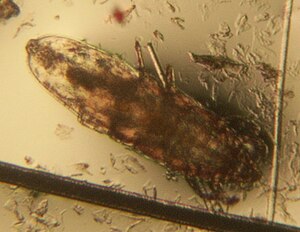Chirodiscoides caviae
| Chirodiscoides caviae | ||||||||||||
|---|---|---|---|---|---|---|---|---|---|---|---|---|

Chirodiscoides caviae |
||||||||||||
| Systematics | ||||||||||||
|
||||||||||||
| Scientific name | ||||||||||||
| Chirodiscoides caviae | ||||||||||||
| Hirst , 1917 |
Chirodiscoides caviae ( syn .: Campylochirus caviae ), hair or fur mite of guinea pigs , is the most common ectoparasite in guinea pigs. Especially sick and weakened animals canshowmassive hair mite infestation . The parasite colonizes the skin surface and is passed on through direct contact. It feeds on cell debris and tissue fluid .
Fur mites are narrow and elongated. The females are 480 × 140 µm in size, the males 340 × 130 µm. Adults and nymphs have four long pairs of legs. All tarsi wear a sticky bell attached to a short sticky handle. The last pair of legs in males is particularly long and bent over like a hook. This is used for attachment to the female during copulation. Males have an appendix with two suction cups at the rear end . The Gnathosoma is clearly triangular.
The entire development cycle takes place on the host. The eggs are fixed in the middle of the hair shaft with a sticky secretion. After hatching, a larval and two nymph stages follow .
literature
Wieland Beck, Nikola Pantchev: Practical Parasitology in Pets: Small Mammals - Birds - Reptiles - Bees . Schlütersche, 2nd edition 2014, ISBN 9783842685185 , pp. 43–45.